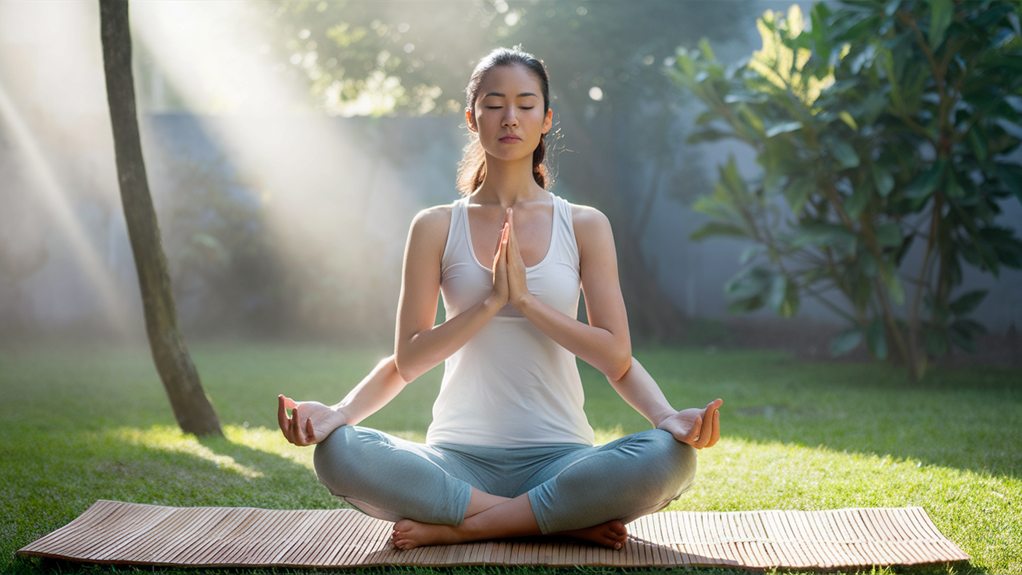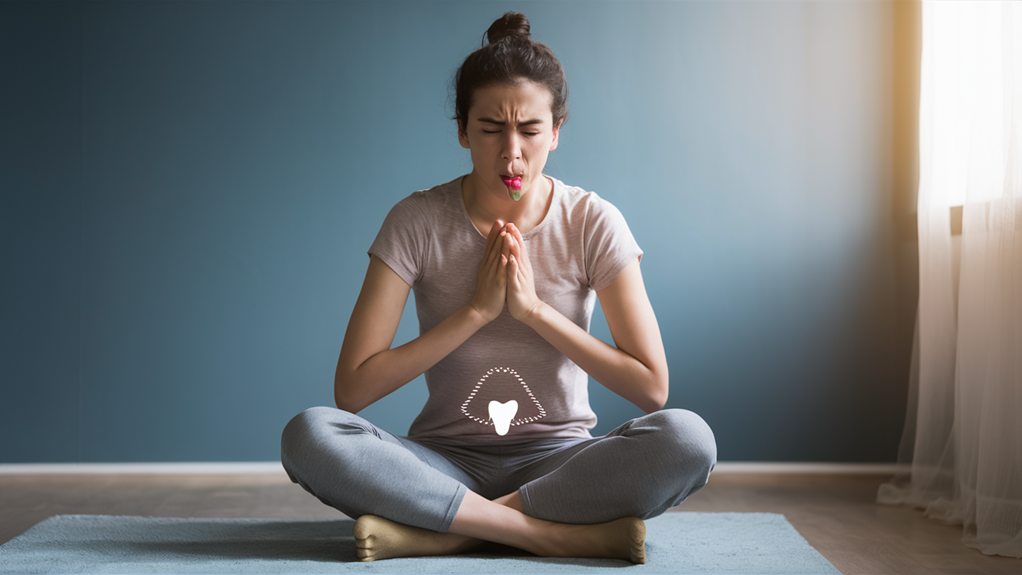Breathing exercises are powerful tools you'll want to master for managing anxiety effectively. When you're feeling anxious, try this simple technique: place one hand on your chest and another on your belly, then breathe in through your nose for four counts, letting your belly expand. Hold for two counts, then exhale slowly through your mouth for six counts, making each exhale longer than your inhale. Practice this for at least five minutes, twice daily, focusing on deep, diaphragmatic breaths rather than shallow chest breathing. With regular practice, you'll develop a natural ability to calm your nervous system and reduce anxiety symptoms, opening the door to even more advanced techniques.
Understanding Anxiety and Breathing Connection

When you're anxious, your breathing becomes rapid and shallow, triggering your body's fight-or-flight response. This physical reaction can make your anxiety worse, creating a cycle that's difficult to break. Understanding this connection between your breathing and anxiety is the first step toward managing your symptoms effectively.
Recognizing the distinction between stress and anxiety can also help you identify what you're experiencing, as understanding stress vs. anxiety can inform your management strategies.
Your body responds to stress by activating your sympathetic nervous system, which increases your heart rate and makes your breathing more rapid. Deep breathing techniques can help reverse this process by activating your parasympathetic nervous system, often called the "rest and digest" response.
When you practice diaphragmatic breathing for anxiety, you're sending signals to your brain that you're safe and in control.
Breathing exercises for anxiety work by helping you focus on slow, controlled breaths that expand your diaphragm rather than shallow chest breathing. This type of breathing increases oxygen flow to your brain, reduces stress hormones, and helps regulate your heart rate.
With regular practice, you'll find that these exercises become natural responses to anxiety, giving you a powerful tool for managing stress in your daily life.
Basic Breathing Techniques
Learning basic breathing techniques provides a foundation for managing anxiety effectively. Regular practice of these techniques can enhance your overall well-being and help mitigate stress levels through the stress-relieving power of exercise.
Through simple, structured breathing exercises, you'll discover powerful tools for breath control for stress that you can use anywhere, anytime. The key is to start with gentle, manageable practices that don't feel overwhelming.
Begin by finding a comfortable position, either sitting or lying down, and place one hand on your chest and the other on your belly. As you breathe in through your nose, count slowly to four while feeling your belly expand like a balloon.
Hold this breath briefly, then exhale through your mouth for a count of six, letting your belly fall naturally. You'll want to repeat this cycle for at least five minutes, focusing on the steady rhythm of your breath.
Another effective technique is box breathing, where you'll breathe in for four counts, hold for four, exhale for four, and pause for four before starting again. This method helps regulate your nervous system and creates a sense of calm.
Deep Breathing Practice Guide

Mastering deep breathing requires a structured approach that builds upon basic techniques.
You'll want to start by finding a quiet, comfortable space where you won't be interrupted for at least 10 minutes. Sit or lie down with your back straight, and place one hand on your chest and the other on your belly to monitor your breath.
Begin by exhaling completely through your mouth, then close your eyes and inhale slowly through your nose for a count of four. You'll feel your belly expand like a balloon while your chest remains relatively still.
Hold this breath for a count of two, then release it gradually through your mouth for a count of six, feeling your belly fall. When you're first starting out, try to practice this cycle for 5-10 breaths.
As you become more comfortable with the technique, you can extend your practice time and experiment with different counting patterns.
Remember to keep your shoulders relaxed and your jaw loose throughout the exercise. If your mind wanders, that's perfectly normal – just gently bring your focus back to your breath without judgment.
Benefits of Mindful Breathing
Practicing mindful breathing delivers both immediate and long-term benefits for your mental and physical wellbeing. When you focus on your breath, you'll notice an instant decrease in muscle tension, lowered heart rate, and a natural shift away from stressful thoughts. This practice not only helps calm your nervous system but also influences brain activity in ways that enhance emotional resilience, as shown in recent studies on mindfulness and its effects on stress levels science behind its benefits.
Your body's relaxation response kicks in, releasing feel-good chemicals that help calm your nervous system.
The long-term advantages of regular mindful breathing are equally impressive. You'll develop better emotional regulation, which means you won't react as strongly to stressful situations, and you'll recover more quickly when you do feel anxious. Your blood pressure often improves, and you'll likely experience better sleep quality and increased energy throughout the day.
What's particularly remarkable is how mindful breathing enhances your mental clarity and focus. You'll find yourself better able to concentrate on tasks, make decisions with greater confidence, and maintain a more balanced perspective during challenging times.
Additionally, you're strengthening the mind-body connection, which helps you recognize anxiety triggers earlier and respond more effectively when they arise.
Common Breathing Exercise Mistakes

While breathing exercises seem straightforward, three common mistakes can limit their effectiveness or even increase anxiety.
First, you're probably breathing too quickly, which can make you feel lightheaded and jittery. This is particularly important to be aware of, as caffeine's impact on anxiety can exacerbate feelings of jitteriness. Instead of rushing through your breaths, take your time and focus on making each inhale and exhale longer and more controlled.
The second mistake you might be making is breathing from your chest rather than your diaphragm. When you breathe from your upper chest, you're not getting enough oxygen, and you'll notice your shoulders rising and falling.
Try placing your hand on your belly and make sure it expands when you inhale, as this indicates proper diaphragmatic breathing.
Daily Breathing Exercise Routine
A consistent breathing routine can transform your anxiety management journey. To make the most of your practice, you'll want to set aside specific times each day, ideally in the morning when you wake up and in the evening before bed. Start with five minutes per session, and gradually work your way up to 10-15 minutes as you become more comfortable.
Incorporating various techniques can enhance your experience; for example, experimenting with mindful breathing techniques can provide additional benefits for relaxation and stress reduction.
Begin each session by finding a quiet spot where you won't be disturbed, and sit or lie down in a comfortable position. Set a gentle timer, and start with four rounds of box breathing: inhale for four counts, hold for four, exhale for four, and hold for four.
Next, move into diaphragmatic breathing, placing one hand on your chest and the other on your belly. Take 6-8 deep breaths, ensuring your belly rises more than your chest.



